Levoča, Spišský Hrad and Associated Cultural Monuments: Levoča is a town in the Spiš region in eastern Slovakia. Levoča was located on a trade route between Hungary and Poland. In the 15th century Levoča became a rich trade centre and an important cultural centre. The historic town Levoča is still surrounded by ancient walls. The main square of Levoča is surrounded by stately town houses. The former Town Hall of Levoča is one of the leading examples of secular Renaissance architecture in Slovakia, the 17th century 'Cage of Shame' was used for public punishment of scoundrels. The Church of St. James houses a Gothic altar made by Master Paul of Levoča, the wooden altar (18.62 m high) is the largest of its kind in Europe. Master Paul of Levoča was one of the best Medieval woodcarvers, he lived and worked mostly in Levoča. The ruin of Spišský Hrad is often regarded as the national symbol of Slovakia. Spišský Hrad is one of the most visited sites in the eastern part of Slovakia. Spišský Hrad (Spis Castle) is standing on the top of a hill and is dominating the surrounding countryside. The castle was built in the 12th century. In the 15th century it became the residence of the nobility. Thanks to the massive fortress walls this guard of the Spiš region was never conquered in battle. It took a raging fire in 1780 to reduce Spišský Hrad to ruins. Associated Cultural Monuments: Spišské Podhradie, one of the few remaining synagogues of the Spiš region can be found in this small town; the village Spišská Kapitula, still surrounded by its ancient walls with the Upper Gate and Lower Gate, the St. Martin's Cathedral and all the other religious buildings in Spišská Kapitula; the 14th century Church of the Holy Spirit in Zehra. Spišský Hrad and the Associated Cultural Monuments gained the status as a UNESCO World Heritage in 1993. Extension of the site in 2009: The historic town of Levoča. The UNESCO World Heritage was inscribed on the UNESCO World Heritage List as: Levoča, Spišský Hrad and the Associated Cultural Monuments.
www.werelderfgoedfotos.nl © Copyright World Heritage Photos

Levoča, Spišský Hrad and the Associated Cultural Monuments: The ruins of Spišský Hrad Castle are standing on top of a hill and are dominating the surrounding countryside of the Spiš region. Spišský Hrad is one of the most visited tourist attractions in the eastern part of Slovakia. Levoča, Spišský Hrad and the Associated Cultural Monuments, such as the Church of the Holy Spirit in Žehra, the towns of Spišská Kapitula and Spišske Podhradie, became a UNESCO World Heritage.

Levoča, Spišský Hrad and the Associated Cultural Monuments: The ruins of Spišský Hrad Castle are standing on top of a hill and are dominating the surrounding countryside of the Spiš region. Spišský Hrad is one of the most visited tourist attractions in the eastern part of Slovakia. Levoča, Spišský Hrad and the Associated Cultural Monuments, such as the Church of the Holy Spirit in Žehra, the towns of Spišská Kapitula and Spišske Podhradie, became a UNESCO World Heritage.
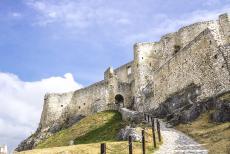
Levoča, Spišský Hrad and the Associated Cultural Monuments: The inner gate of Spišský Hrad. Spišský Hrad was built in the 12th century and is one of the largest castles in Central Europe. Thanks to the massive fortress walls, high cliffs and other defensive works, the castle was never conquered in battle. It took a raging fire in 1780 to reduce Spišský Hrad into ruins. Spišský Hrad and the Associated Cultural Monuments gained the status as a UNESCO World Heritage in 1993.

Levoča, Spišský Hrad and the Associated Cultural Monuments: The courtyard of Spišský Hrad is inhabited by several animal species, such as a colony of ground squirrels, the spermophile, the ground squirrels are small mammals, about 18-20 cm long, their weight is about 300 grams, the coat is yellow-brown in colour. The town of Spišske Podhradie lies at the foot of Spišský Hrad. Spišske Podhradie is one of the associated cultural monuments of the UNESCO World Heritage.
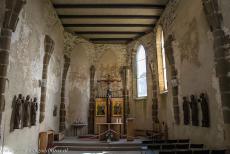
The town of Levoča, Spišský Hrad and the Associated Cultural Monuments: The Gothic Chapel of St. Elizabeth in Spišský Hrad Castle was built in the 15th century. The castle chapel was used as a private place of devotion for the noble family of Spišský Hrad. In the 17th century, the chapel became a funeral chapel, the crypt is situated beneath the sandstone floor. The chapel was the first religious building in the vicinity of Spišský Hrad Castle.
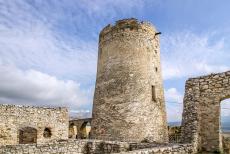
The town of Levoča, Spišský Hrad and the Associated Cultural Monuments: The Bergfried is one of the remaining towers of Spišský Hrad. Spišský Hrad was built in the 12th century. In the 15th century, the castle became the residence of the nobility of Slovakia. Spišský Hrad is also known as Spiš Castle. Spišský Hrad houses a museum with medieval objects. Spišský Hrad is situated near the town of Levoča and close to the Church of the Holy Spirit in the small village of Žehra.

Levoča, Spišský Hrad and the Associated Cultural Monuments: The Church of the Holy Spirit in Žehra. On the right hand side the ruins of Spišský Hrad. The Church of the Holy Spirit in Žehra was built in 1274. The onion-shaped wooden spire dates from 1769. The church is adorned with frescoes dating from the 13th and 14th centuries. The Romanesque-Gothic Church of the Holy Spirit is situated on a hill in the small village of Žehra. The church is a UNESCO World Heritage.
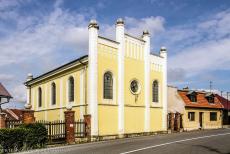
Levoča, Spišský Hrad and the Associated Cultural Monuments: The synagogue in the town of Spišské Podhradie is one of the few remaining synagogues of the Spiš region. The synagogue is a typical example of the late 19th century provincial synagogue architecture. The Synagogue of Spišské Podhradie is situated on the Slovak Jewish Heritage Route. The small town of Spišské Podhradie is situated at the foot of the ruins of Spišský Hrad Castle.

Levoča, Spišský Hrad and the Associated Cultural Monuments: The walls of Spišská Kapitula, in the far back ground Spišský Hrad Castle. The walls of Spišská Kapitula were probably built in the 13th century, the defensive town walls are one metre wide and 4 to 5 metres high. The town of Spišská Kapitula was built around a low hill, the Mons Sancti Martini, with St. Martin's Cathedral on top. The Roman-Catholic Church has a seat in Spišská Kapitula since the 13th century.
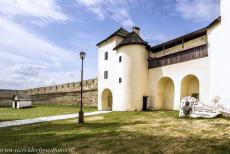
Levoča, Spišský Hrad and the Associated Cultural Monuments: The Upper Gate is one of the city gates of the ecclesiastical town of Spišská Kapitula. The inhabitants of the ecclesiastical town are mostly Spiš Holy See officials, the clergy and servants. Spišská Kapitula consists of a cathedral, a monastery and seminary. The town has only one street, lined with some thirty houses. The town of Spišská Kapitula is still surrounded by medieval walls, one of the most complete in Slovakia.

Levoča, Spišský Hrad and the Associated Cultural Monuments: The clock tower of the town of Spisská Kapitula was erected in 1739. Spišská Kapitula became the seat of the Spiš Holy See in 1776. Spišská Kapitula has still preserved its religious character. Spišská Kapitula is often called the Vatican of Slovakia. Spišská Kapitula is part of the UNESCO World Heritage: Levoča, Spišský Hrad and the Associated Cultural Monuments.
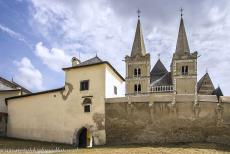
Levoča, Spišský Hrad and Associated Cultural Monuments: Behind the medieval town walls of Spišská Kapitula liest the St. Martin's Cathedral. The Romanesque cathedral was built between 1245-1273, the towers were completed around 1270. The cathedral was rebuilt in the Gothic style between 1462-1478. The towers have preserved their Romanesque character, as well as the pillars of the central nave and a part of the northern wall with a small Romanesque window.

Levoča, Spišský Hrad and the Associated Cultural Monuments: Above the entrance door of the St. Martin's Cathedral in Spišská Kapitula is a mural dating from 1317, depicting the Coronation of Charles Robert d'Anjou, King of Hungary. The mural was likely created by an Italian painter. The oldest part of the interior furnishing of St. Martin's Cathedral is a sculpture of a white lion, known as the Leo Albus, one of the few remaining Romanesque sculptures in Slovakia.

Levoča, Spišský Hrad and the Associated Cultural Monuments: The St. Martin's Cathedral inside the town walls of Spišská Kapitula. The cathedral is the final resting place of the lords of Spišský Hrad. Several parts of the cathedral are Romanesque. The cathedral has a beautiful decorated vaulted ceiling, a number of wall paintings and houses medieval altars. Opposite the St. Martin's Cathedral stands the Gothic Palace of the Bishop.

Levoča, Spišský Hrad and the Associated Cultural Monuments: The town walls of Levoča and the Košice Gate, one of the surviving town gates of Levoča. The town was situated on a major trade route. In the 15th century, Levoča became a wealthy trading centre. The historic town of Levoča is still surrounded by medieval town walls, they were constructed in the 14th and 15th centuries and are about two kilometres long, several bastions and two town gates are preserved.

The town of Levoča, Spišský Hrad and the Associated Cultural Monuments: The house of Master Paul of Levoča is situated on the central town square. Master Paul of Levoča was one of the best medieval woodcarvers, he lived and worked mostly in Levoča. The house where Master Paul of Levoča lived and worked is now a museum. The Basilica of St. James in Levoča houses a wooden altar sculpted by Master Paul of Levoča, this Gothic altar is the largest of its kind in Europe.
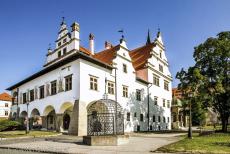
The town of Levoča, Spišský Hrad and the Associated Cultural Monuments: The Old Town Hall of Levoča and the 17th century 'Cage of Shame'. The Town Hall of Levoča was built in the Gothic style in the 15th century and rebuilt in the Renaissance style in the 17th century. The 'Cage of Shame' was used for public punishment for minor law-breaking. Lawbreakers were locked up in the cage for several hours or days. The cage was often used during fairs, festivals and markets.
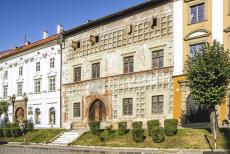
Levoča, Spišský Hrad and the Associated Cultural Monuments: The central square of Levoča is surrounded by burgher houses. The ruins of Spišský Hrad Castle and the Associated Cultural Monuments gained the status as a UNESCO World Heritage in 1993. Extension of the site in 2009: The historic town of Levoča. Today, the UNESCO World Heritage Site is inscribed on the UNESCO World Heritage List as: Levoča, Spišský Hrad and the Associated Cultural Monuments.
